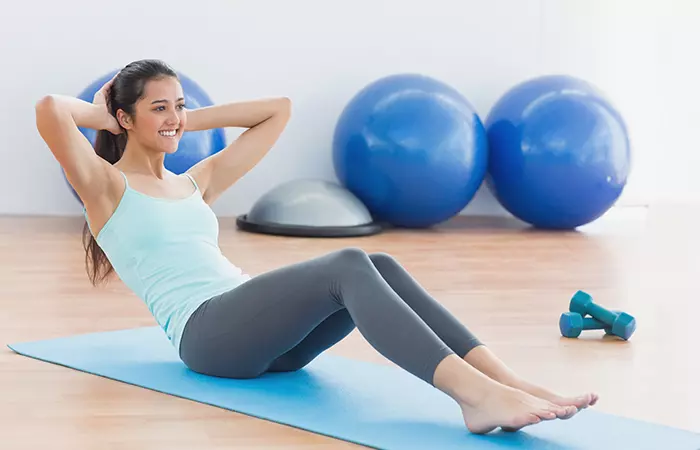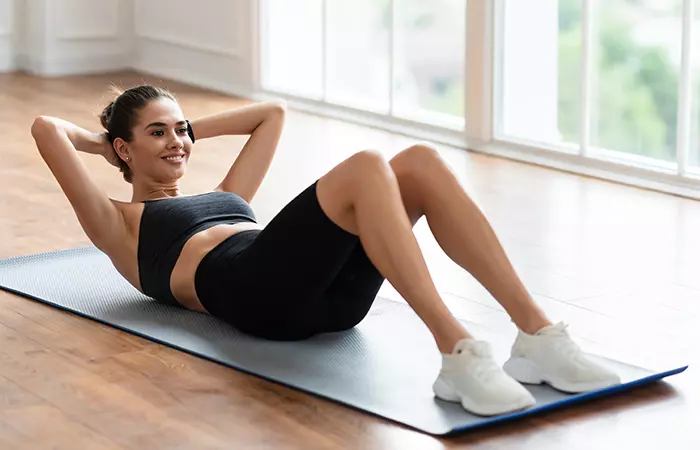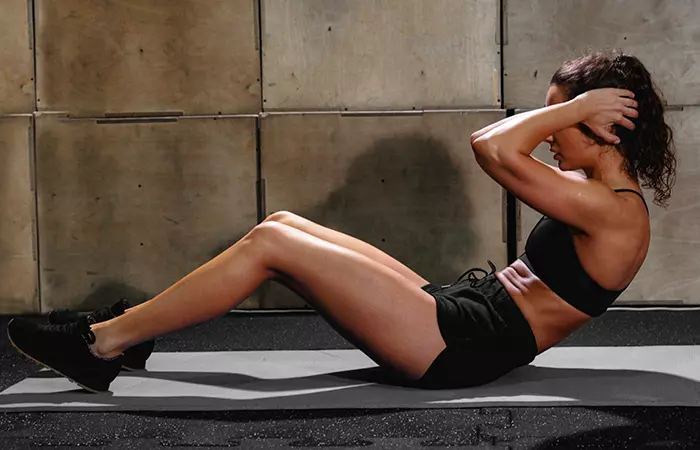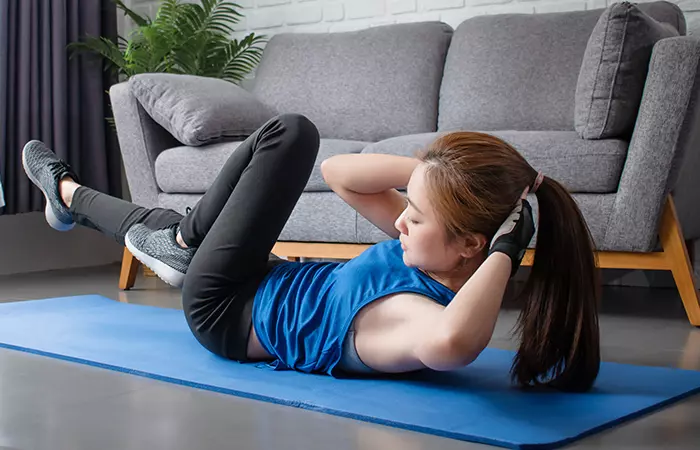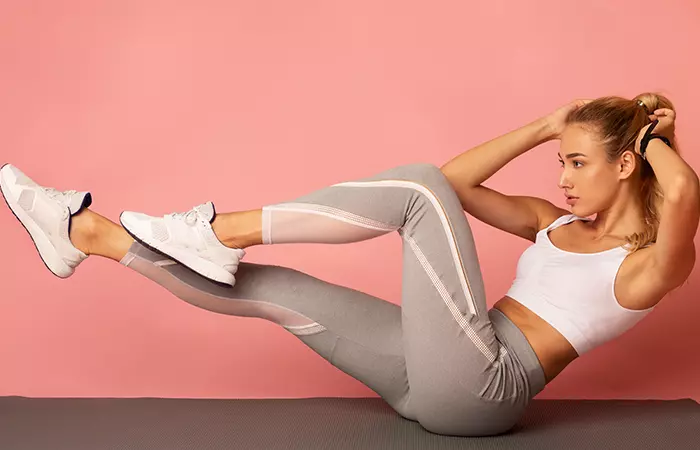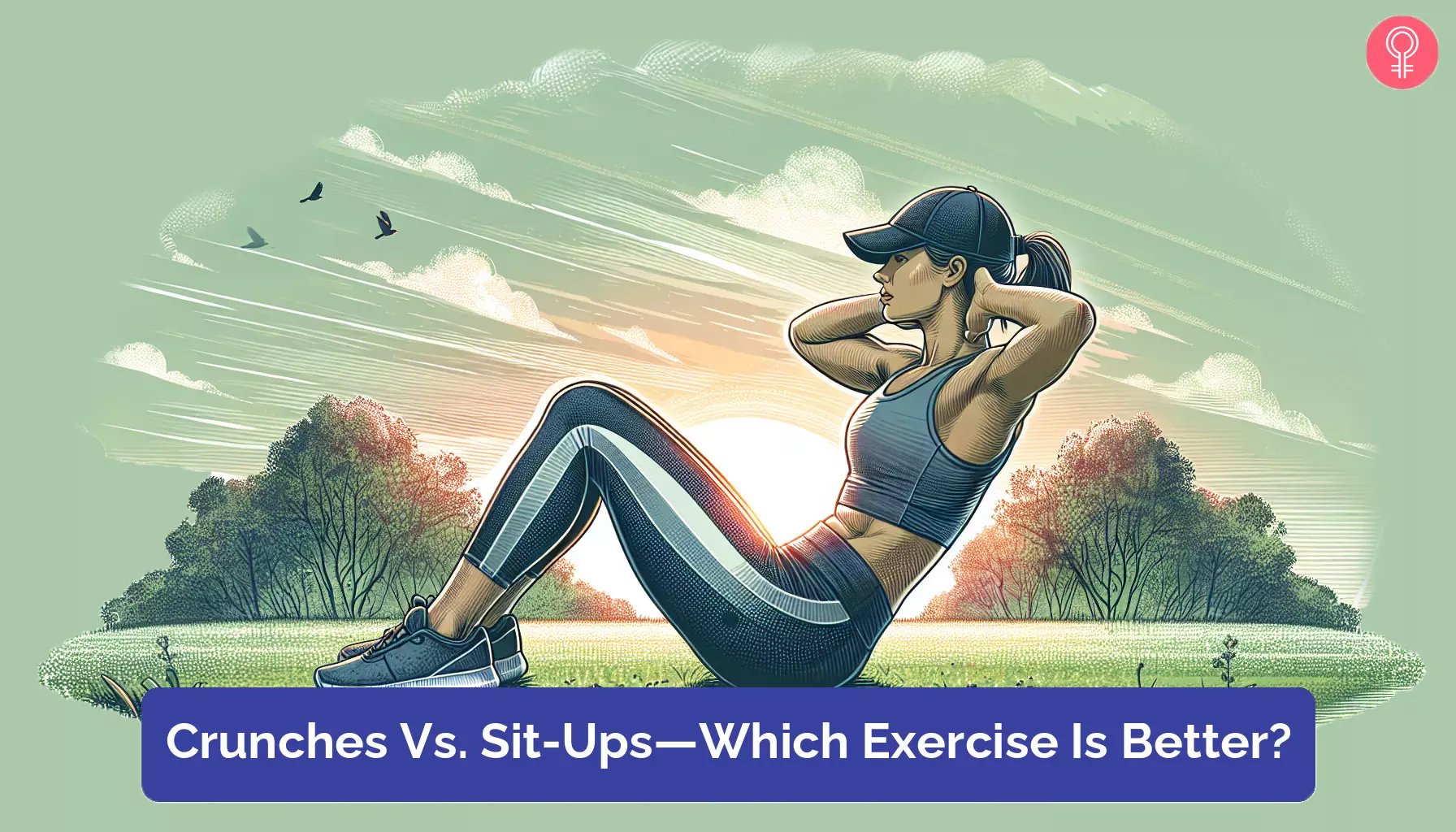What Are Sit-Ups?
Sit-ups target the abdominal muscles and help strengthen and tone the core. They involve lying on the floor on your back and lifting the torso. Sit-ups have a wider range of motion which helps in targeting more muscles than crunches. Sit-ups mainly engage rectus abdominis muscles, which run vertically along the front of the torso (1). They are also effective on the transverse abdominis and oblique muscles in the abdomen, which helps get those chiseled abs. Furthermore, sit-ups also help improve posture by working on the hip flexors, which run from the thighs to the lower back and gluteal muscles. Sit-ups are easy to do if you follow the right techniques. How To Do Sit-Ups Follow these steps to do sit-ups accurately:
What Are Crunches?
Crunches are a classic core exercise that specifically trains the abdominal muscles. They have a smaller range of motion compared to sit-ups. A crunch is also known as a half sit-up, as the lower half of the body remains on the floor. Crunches work on the rectus abdominis and obliques—the muscles along the sides of the stomach, thereby helping you get the coveted six-pack abs. Crunches also put less strain on the spine and are very useful for people who want to target their abs. Here’s how to do crunches properly. As Personal Trainer Hannah Shine says, “Crunches are very useful for people who want to target their abs,” if you are one of those people, here’s how to do crunches properly. How To Do Crunches Follow these steps to do basic crunches accurately: Additionally, you can also do variations of crunches like the side-oblique, bicycle, and toe-tap crunches. The various types of crunches you can try out include:
Basic Crunch: Lie on your back with knees bent, hands behind your head, and lift your upper body off the ground. Reverse Crunch: Similar to the basic crunch, but you need to lift your legs and pelvis off the ground, targeting the lower abs. Oblique Crunch: Involves twisting your torso to work the oblique muscles on the sides of your abdomen. Bicycle Crunch: Mimics a pedaling motion, engaging both upper and lower abs. Vertical Leg Crunch: Lift your legs upward to target the lower and upper abdominal muscles. Long Arm Crunch: Extend your arms to work the upper part of the abs. Plank With Knee-To-Elbow: Combines a plank position with knee-to-elbow movements for a full-core workout. Side Plank Crunch: Involves a side plank while adding a crunch to work the obliques.
Both crunches and sit-ups are great for toning the abdominal muscles, depending on your workout goals. However, both have advantages and disadvantages. Read on to learn more about them.
Pros And Cons Of Sit-Ups And Crunches
Pros Of Sit-Ups
- Works Multiple Muscles Sit-ups help work the abdominal muscles by explicitly targeting them and working on them from different angles. They engage the abdominals while targeting other muscle groups like hip flexors, lower back, chest, and neck.
- May Improve Core Strength Since sit-ups tighten and tone the abdominal muscles, including them in your workout routine may help strengthen core muscles. A strong core is linked to improved endurance and performance in athletes (2). Moreover, sit-ups make your everyday activities easier.
- May Improve Posture A strong core helps maintain spine, shoulders, and hips alignment. Therefore, sit-ups help improve posture by reducing pain and tension and raising energy levels.
- Improves Flexibility And Stability Sit-ups improve stiffness by relieving tension and tightness in the spine and increasing mobility and flexibility. A strong core also improves the balance of the body, keeping you stable and making you less likely to fall and injure yourself.
- May Improve Pulmonary Function Compared to traditional exercises, core exercises like sit-ups focus on diaphragmatic breathing (breathing in through the nose and out through the mouth). This may help improve pulmonary function and respiratory health (3).
Cons Of Sit-Ups
May Cause Spinal Injuries
It is challenging to prevent the rounding of the back as you lift your torso for sit-ups, which increases the risk of back pain. It adds tension to the lumbar vertebrae and increases the chances of spinal injuries. Furthermore, it can also cause rupturing or bulging of the disc due to repeated flexion. In case of prior injuries, consult a doctor before doing sit-ups.
May Injure The Neck
There is a substantial risk of neck injury if you lift your head incorrectly with your shoulders off the ground. It is advised to place your hands behind the head to support the cervical spine to avoid discomfort. The safest way is to do this as part of gym routines under the supervision of an instructor. Keep reading to learn about the pros and cons associated with crunches.
Pros Of Crunches
Helps Define The Abs
Crunches are best for targeting only the abdominal muscles and getting perfectly defined upper abs. They are also great when aiming for repeated sets of the same exercise.
Lowers Strain On The Back
Crunches involve a smaller range of motion, lowering the risk of injury. In addition, the minimal movement exercise allows you to strengthen the core without putting much strain on the back.
Easy To Master
Crunches focus on lifting the head and shoulders off the ground, making it a beginner-friendly and easy-to-master exercise. You can do this bodyweight exercise without any gym equipment.
May Improve Endurance
Crunches are great for improving abdominal endurance. A study found that doing crunches at least one day weekly improved abdominal endurance in untrained adolescents (4). While crunches are great for achieving chiseled ab muscles, they have a few downsides.
Cons Of Crunches
May Not Strengthen The Core
Crunches only engage specific abdominal muscles in the core, so they may not help strengthen the entire core and just a part of it. Moreover, they only help in muscle development and not burning fat.
May Injure The Back
Crunches involve the flexing of your spine, which may increase the risk of back and neck injuries. Hence, in case of prior neck or back injuries, consult your doctor or a trained fitness expert before doing these exercises. To know which is better, sit-ups or crunches, check the below section!
Sit-Ups Vs. Crunches: Which Is A Better Workout?
Both sit-ups and crunches work on the core; however, sit-ups target multiple groups of muscles, including hip flexors, compared to crunches, which isolate the muscles in the abdomen, thereby selectively working on the core. In this debate, the winner depends entirely on you and your goals. If you want to focus on a different group of muscles, consider doing sit-ups, and if you’re going to focus on getting chiseled abs, then consider doing crunches. Crunches have also been found to cause less strain on the spinal cord, while sit-ups cause flexing of the spinal cord, thereby increasing the risk of back or neck injuries. Sit-ups involve more tremendous implications on the lower back as they involve overreliance on the hip flexor muscle group. Sit-ups need the assistance of another person or any anchor or support for proper execution, whereas crunches can be done without help. Crunches are also an easier form of core workout for beginners, whereas sit-ups are slightly challenging. Stella Baird, a lifestyle blogger, shared her fitness routine in one of her blog posts. She said, “Maybe this makes me weird, but I love sit-ups! I just think they’re so fun. I tend to have a love-hate relationship with crunches, but they’re very beneficial for your core (i).” Sit-ups or crunches – which is the best six-pack workout? According to fitness trainers, crunches are the best to include in workouts for getting six-pack abs as they target isolated abdominal muscles. Is it OK to do sit-ups with crunches every day? Yes, you can do daily sit-ups with crunches, but make sure your form is correct for they can cause spinal injuries. Are sit-ups better than crunches for an abs workout? Crunches are better for ab workouts as they specifically target ab muscles, with minimal risk of injury.
Illustration: Crunches Vs. Sit-Ups—Which Exercise Is Better?
